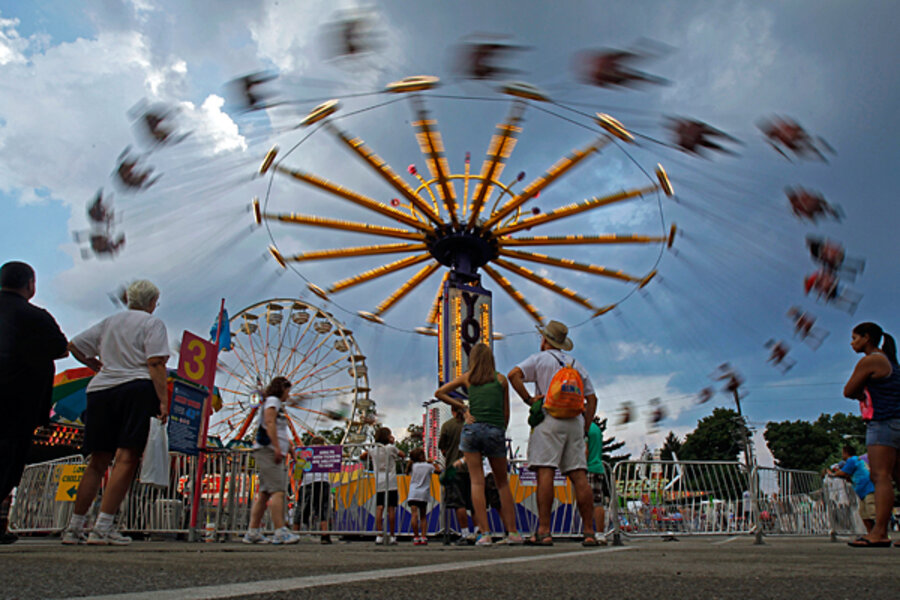Are music concerts getting any safer since Sugarland stage collapse?
Loading...
The plot thickens surrounding who will be held responsible for the stage collapse last August at the Indiana State Fair, in which seven concert-goers died, even as calls escalate for the establishment of common safety standards across the concert industry.
One of two recent reports about the accident criticizes state officials for indecisiveness and a muddled chain of command concerning whether to postpone the concert by the band Sugarland, due to expected bad weather and high winds. The other report cites flaws in the stage's construction and lack of proper inspection.
All parties involved are pointing fingers at one another, given expected lawsuits by the victims' families seeking tens of millions in damages. A lawyer representing several families of the dead or injured says a court suit could be brought by year's end.
Indiana Gov. Mitch Daniels (R) said Monday that the incident points to a “global problem that demands global standards” in the concert industry. He said he had faith in the Event Safety Alliance, a group of concert industry professionals formed this year to recommend safety standards akin to those established 13 years ago in Britain. The group met with Governor Daniels Monday to discuss its recommendations.
Jim Digby, the group’s executive director and the production manager for the rock band Linkin Park, says the aim is to streamline the British safety standards for the US. The hope, he says, is to eventually devise a “framework for inspection” that will “create a dynamic and cultural change across the industry.”
“There is no common language currently between buyer and show producer for the safety discussion," Mr. Digby says in a phone interview. "All of us should be playing from this playbook.”
Concert safety expert Paul Wertheimer of Los Angeles, who contributed to the British standards, says the problem remains that those standards are not enforceable. Indiana's governor, he says, is “stonewalling … to cover the tracks of his administration,” which represented “the last in the chain of command” in determining if the concert should have been canceled or postponed.
In the end, a a powerful storm ripped down the stage scaffolding. In addition to the seven dead, 58 people were injured.
The rigging for the outdoor stage was not strong enough to withstand the storm's 59-mile-per-hour gusts, according to one state-commissioned study by the engineering firm Thornton Tomasetti of Chicago. Nor was the stage structurally sound or properly inspected, the study found.
A second study, by Witt Associates, an emergency preparedness consulting firm in Washington, said that Sugarland representatives repeatedly refused to postpone the concert, despite concerns by state police and fair officials and despite weather alerts that the storm was approaching. Rather, band representatives worried that a postponement would complicate a concert the next night at the Iowa State Fair. The Witt report said that the Indiana State Fair executive director, Cindy Hoye, offered “to cover the cost of additional stage hands in Des Moines if [the band were] delayed.”
But if the report notes resistance from Sugarland reps, it also suggests that confusion and ambiguity among state fair and police authorities contributed to the chain of events leading up to the tragedy. There was no clarity about who was ultimately responsible for deciding whether to cancel or postpone the concert, the report said. Nor did fair officials have proper evacuation procedures in place, it said.
Attorney Kenneth J. Allen of Valparaiso, Ind., who represents the families of three people who died and four who were injured, says the band and its management are more to blame than are Indiana officials. The Witt report, he says, confirms that the band ignored repeated warnings about the emergency weather conditions.
“There is plenty of fault to go around. However, it’s important to determine who’s at the top of the decision chain,” says Mr. Allen. “The performers, at the end of the day, had the prerogative.”
Allen, one of several attorneys seeking tens of millions of dollars in damages on behalf of the dead or injured, says he is “pushing for a trial within a year.” He represents some of the parties to a civil lawsuit filed Nov. 22 in Marion Superior Court in Indianapolis claiming that Lucky Star, the company representing Sugarland, concert promoter Live Nation, Mid-America Sound Corp., and several other companies were primarily responsible for the accident.
Indiana lawmakers voted in March to allow victims to seek more than the $5 million maximum liability allowed under state law.
Last week, Sugarland singer Jennifer Nettles denied responsibility for the disaster.
“I don’t feel it’s my responsibility or my management’s responsibility to evacuate the fans in case of danger. Do I care about their safety? Absolutely,” Ms. Nettles said in a deposition.
In a response to the civil suit, Sugarland attorneys said in February that the band “had nothing to do with any construction of the venue” and insisted that the band had no authority to cancel the concert because of the threat of inclement weather.
“The incident … resulted from a gust of wind at unprecedented intensity … which caused a structure that may have been improperly designed, maintained and/or inspected to fail. As such, this was a true accident or Act of God,” the band’s attorneys wrote.
Stephanie McFarland, a spokeswoman with the Indiana State Fair Commission, says the recommendations made by the two reports, as well as those of the Event Safety Alliance, will be in place by this year’s fair in early August.
“Any outdoor structure will have the highest standard by the state and by the industry” in an effort to make the Indiana fair “the model for other fairs, not only in Indiana, but in other states and beyond,” Ms. McFarland says.
Get daily or weekly updates from CSMonitor.com delivered to your inbox. Sign up today.







